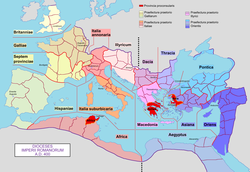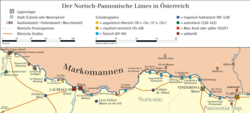Limes (Roman Empire)
Limes (plural limites) is a modern term used for the Roman border defence in Germany. It marks the borders of the Roman Empire, though it was not used by the Romans for this purpose.[1][2]
| UNESCO World Heritage Site | |
|---|---|
 The limes Germanicus, 2nd century | |
| Location | The valleys of the Rhine and the Danube; Britain. |
| Includes | Hadrian's Wall, Roman defenses along the Cumbrian coast, and the Limes Germanicus; the Antonine Wall is a later addition to this site |
| Criteria | Cultural ii, iii, iv |
| Reference | 430 |
| Inscription | 1987 (11th Session) |
| Extensions | 2005, 2008 |
| Area | 526.9 ha |
| Buffer zone | 5,225.7 ha |
The term has been extended to refer to the frontier defences in other parts of the empire, such as in the east and in Africa. It is used by the World Heritage site bureaucracy to include the two walls in Britain, the Antonine Wall and Hadrian's Wall.
The Limes is often associated with Roman forts, but it could apply to any area near the walls where the Romans exercised loose control with military forces.
Limes (Roman Empire) Media
Northern Frontiers in 337 AD showing the reconquests of Constantine the Great
Map of forts and walls in North Britain around 155 AD (most forts on and south of Hadrian's Wall have been omitted)
References
- ↑ Benjamin Isaac 1988. The meaning of 'Limes' and 'Limitanei' in Ancient Sources. Journal of Roman Studies, 78, pp. 125–147.
- ↑ Great Walls and Linear Barriers, Peter Spring, Pen and Sword, 2015, Chap. 24. ISBN 1473853842, 9781473853843
![]()









